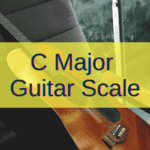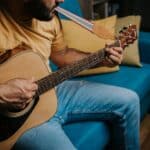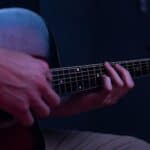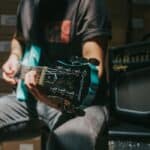Funk is a danceable musical style.
Yes, it has a reputation for making people move in a matter of seconds.
But how does Funk achieve this difficult goal of making an entire club move to the same beat? Well, we’re here to reveal all the secrets in the Funk recipe.
Get your mirror Stratocaster and your fancy sunglasses, and jump on those platform shoes because things are about to get really Funky.
Are you ready to Funk? I said, ARE YOU READY TO FUNK!?
Let’s do this then!
What Do You Need to Funk?
Funk is a rather simple musical style to play; it doesn’t need any specific Funky equipment to sound great.
On the contrary, to Funk you need to ride the minimalist wave and try playing your guitar clean and compressed to keep the percussive element of your playing right on top of the speakers.
So, let’s talk about what you need to Funk:
- A Clean Amp – The first thing that Funk requires from a guitar player is a loud and clean amp to play the Funky parts with. I know what you’re thinking: “What about Lenny Kravitz?” Well, every rule has an exception; plus, he is a Funk rocker. That being said, a loud and clean amp is what you need to play Funk.
- A Compressor Pedal – Compressor pedals usually have a bad reputation for killing dynamics and erasing the natural nuances of your playing. Yet, if you learn how to use the right amount of compression, the guitar tone will jump out of the speakers and hit people in the ear directly.
- A Single-Coil Guitar – I know what you’re thinking… but what about Lenny Kravitz? Well, again, he’s a rocker and a Funk player; in that order. So, to play the syncopated, percussive, rhythmic patterns Funk demands and, more importantly, to keep the amp clean, you need a single-coil guitar. Ideally, a Stratocaster to play through positions 2 and 4 and engage that Funk mojo effortlessly.
- A Filter Pedal – No Funk setup is finished without a filter pedal (or two). You can buy a manual filter pedal we all know and love which is called “wah-wah”. Otherwise, to have more stage freedom, you can always get an Auto-Wah or a Q-Tron filter or anything similar.
- Ghost Notes – Finally, when playing Funk on the guitar, you must learn how to play ghost notes between chords. You do this by muting the strings on your guitar with the fretting hand and strumming synced with the band’s tempo. This is paramount to making people move and dance.
Funk-Friendly Instruments
We learned about the crucial elements to play Funk, but what are the guitars that can help you achieve that amazing Funk tone effortlessly?
Let’s see some recommendations:
Stratocasters & Telecasters
The Stratocaster is the perfect Funk guitar, period.
Let me clear this up for you a little because that statement might sound a little bossy.
The thing about Stratocasters is that they have been the instrument of choice for Funk players for decades.
Thus, our ears associate that audio with Funk.
Also, the positions 2 and 4 as well as the bridge pickup make Stratocasters perfect Funk machines.
When talking about telecasters, things change because the telecaster has a more aggressive twang that can take you to country territory in a second.
So, with due care not to go there, the telecaster’s snap and middle-position warmth can be great for your Funky tones.
PRO TIP: Don’t shy away from maple necks when playing Funk. I know it can be a little harsh when trying to go for a more melodic approach, but maple can cut through even the densest mix. You can ask Mr. Hit Song himself, Neil Rodgers what he thinks about his “Hitmaker” Strat with a maple neck.
Jazzmasters & Jaguars
Although these instruments are associated with a different musical style known as surf music, they make amazing Funk instruments as well.
To begin with, Jazzmasters are experiencing an amazing boom that has taken them to the biggest stages in the world in the hands of all kinds of players.
The fact that they combine a Fender-friendly tone with P-90s makes them absolute winners in Funk.
Jaguars, on the other hand, don’t have P-90s but single coils, which make them great to be played loud, compressed, and clean.
Furthermore, it was John Frusciante’s first guitar when he made it back to the Red Hot Chili Peppers to record Californication.
Here’s a clip of the man himself with his fiesta red jaguar playing in Stockholm in 1999.
Semi-hollow body guitars
What? Weren’t we talking about the wonders of compressing single coils to play Funk? What are these humbucker-loaded big yachts doing on this list? Well, Jimmy Nolen, the guitarist responsible for inventing Funk as James Brown’s main guitarist did his best playing on a semi-hollow body guitar. But that’s not all, Freddie Stone of Sly and the Family Stone, Al McKay of Earth, Wind & Fire, and Tony Maiden of Rufus all made their names playing Gibson ES-335 style guitars.
The secret is lowering the volume to keep the percussiveness of the hollow body and none of the grit from the humbuckers.
Here’s the man himself ripping it on stage next to soul brother number one, James Brown. Pay close attention to the maple neck he uses to get that extra high-end percussive element.
Introducing Funk Chords
Funk utilizes some well-known chords and some other chords that might have escaped your radar for a long time.
Yes, this upbeat style isn’t constructed using only major chords as you might have expected.
On the contrary, the different flavors are needed to spice up the simple chord progressions and insane rhythmic elements.
These are the types of chords you should be looking at.
- Seventh Chords
- Ninth Chords
- Thirteenth Chords
Let’s look at an example of each of these chords so you can get an idea of what we’re talking about.

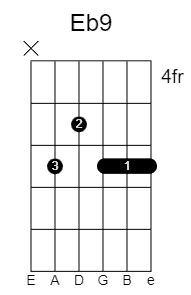
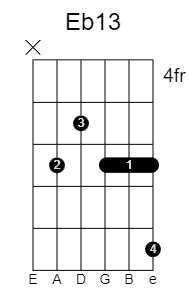
As you can see, these four-note chords are much more textured and welcome than traditional triads when playing tight rhythmic structures.
The Secret is Making Room for the Groove
Perhaps, the most important aspect of playing guitar in a Funk ensemble or band is that you need to make room for the groove.
This means you should stay away from playing big chords such as open chords or full bar chords.
Why? You might be asking as you scratch your head with that medium-light, Funk-ready pick.
Well, because the grooving bass lines that are locked in with the kickdrum need to do the heavy lifting for people to dance.
So, your approach to building chords should be minimalistic and middle-and-treble oriented.
In summary, the secret to a good Funk tune is to move out of the way and spice up the composition with your strumming and groundbreaking small chords.
A Very Traditional Background
Finally, we need to address what is going on around you in the song as you’re playing those small chords and shapes.
Well, most Funk bands lay their groove over a very simple background in 4/4 with kickdrums in 1 and 3 and snares in 2 and 4.
I mean, that’s the usual, basic figure.
It can be changed (I’m talking to you, Chad Smith) for some more complex patterns, but the result should always be the same: a groovy, simple structure for the bass player to play some intricate, syncopated, parts locked in with the kickdrum (I’m talking to you, Flea).
On top of that, the sauce is your guitar playing, laying smaller versions of the chords you already know and playing your guitar more as a percussive instrument than a melodic one (I’m talking to you, John Frusciante).
Finally, the singer should put some danceable bits on top and make the people dance, sing, and lose their minds to your music.
So, in summary, guitarists need to embellish a simple background with a groovy bass line. I’m sorry to break your heart here, but groove is the king of Funk, not guitar.
15 Great Funk Chord Progressions
- I7 – I7 – I7 – I7
- iv – VI – i – VII
- ii – ii – ii – ii
- ii – IV – ii – IV
- I7 – I7 – I7 – I7 – VII7 – VII7 – VII7 – VII7
- i – iv – V
- IV7 – I7 – IV7 – I7
- iv – i – VII – i
- i – i – i – i – IV7 – IV7 – V7 – i
- I7 – IV7 – I7 – V7 – IV7 – I7
- i7 – I7
- V7 – (V7 – IV – I)
- ii7 – ii7 – V7 – V7
- ii7 – V7 – bVII – (IV – I6)
- (V7 – IV) – IV – V – V
The Bottom End
Funk is a style that enhances the guitar’s percussive element and turns it into a rhythm machine rather than a melodic component.
Practice these songs with their chord progressions and learn how to transform your playing to get people dancing effortlessly.
Happy (percussive) playing!

Hello there, my name is Ramiro and I’ve been playing guitar for almost 20 years. I’m obsessed with everything gear-related and I thought it might be worth sharing it. From guitars, pedals, amps, and synths to studio gear and production tips, I hope you find what I post here useful, and I’ll try my best to keep it entertaining also.


